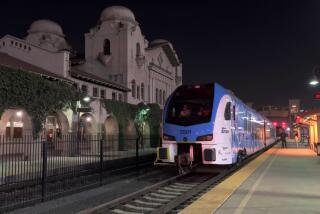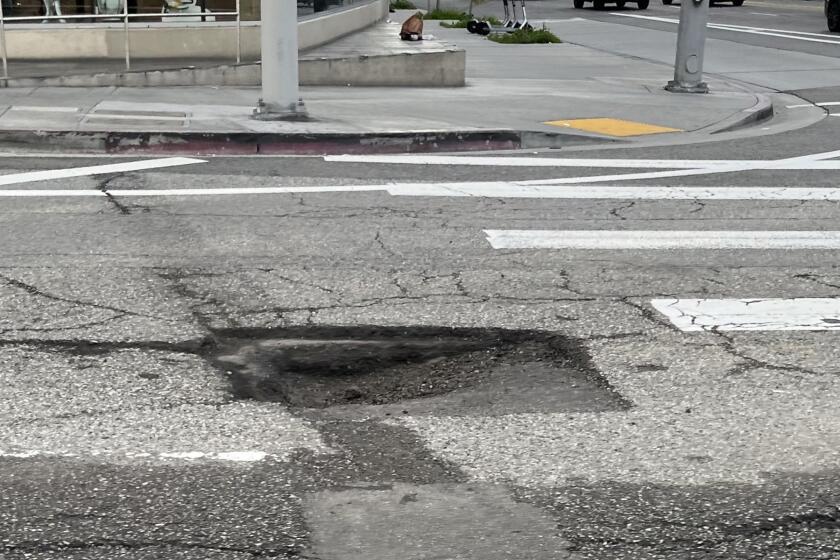Amtrak’s New High-Speed Service Is Derailed by Mechanical Problem
- Share via
WASHINGTON — A mechanical problem sidelined Amtrak’s heavily promoted Acela Express train Tuesday, a day after it began regular passenger operation as America’s first high-speed rail service.
To make matters worse, unrelated problems prevented use of a backup Acela Express train, and a conventional train dispatched as a replacement on the Washington-to-Boston route broke down north of New York.
Amtrak officials promised to compensate affected riders.
“There are going to be episodes such as this whenever a new service starts. Obviously, we would have hoped it wasn’t the second day,” said Amtrak spokesman Rick Remington. “But we’re going to learn lessons from this and make sure it doesn’t happen again.”
The two Acela Express trains are the first of 20 that Amtrak is receiving from Bombardier Transportation of Canada and Alstom Ltd. of France. All 20 are supposed to be running in the Northeast Corridor by next summer.
Acela Express, with its distinctive tapered nose and upgraded seats and amenities, had a successful debut Monday with a round-trip between Washington and Boston.
But upon its return to Washington, inspectors discovered “minor damage” to a hinged metal assembly that connects the train to overhead electrical lines, Remington said.
Mechanics repaired the assembly--called a pantograph--but not in time for the train to leave Washington at 5 a.m. for its second day of service.
Amtrak turned to a second Acela Express train, being held in reserve. Inspectors found shortcomings with the train as well, including an inoperative freezer and a lack of hot water in the cafe car, Remington said.
So the railway brought in a conventional Metroliner train for the Washington-to-Boston run, but the bad news continued. The train’s engine failed near Bridgeport, Conn., and the arrival in Boston was more than two hours late.
Minus passengers and with its pantograph repaired, the first Acela Express train traveled to Boston in late morning. Remington said it would reenter service for the southbound trip leaving Boston’s South Station at 5:12 p.m.
Amtrak, which introduced a guarantee of good service this year, lost little time in offering refunds to passengers. Remington said passengers on the Metroliner train when its engine failed will get full refunds, while others will be reimbursed the difference--up to $21--between a Metroliner fare and an Acela Express fare.
Amtrak officials sought to limit any public relations fallout by describing the mechanical problem as minor and the company’s reaction as exceedingly cautious.
The equipment problem “is nothing that is specific to high-speed rail,” said Amtrak spokeswoman Cecilia Cummings. “It’s just one of the mechanical vulnerabilities of electric trains.
“Because it’s the Acela Express, we wanted to err on the side of double, double, super caution, so we pulled it” out of service.
Pantographs, which are attached by hinges to the roof of a train’s locomotive, are susceptible to wear on trains of any speed. In 1999, a high-speed train in Japan had to stop for repairs after a stray plastic sheet attached to and damaged its pantograph.
Remington did not blame the Acela Express’ manufacturers for the problem with the pantograph but said Amtrak would seek answers about the glitches on the backup train. The consortium maintains the trains after manufacturing them.
Gilles Paget, spokesman for Bombardier, said the backup train was not scheduled to be ready for service as of Tuesday. It now is.
“There’s going to be some minor adjustments at the very beginning of the service of these new train sets, but these are minor things that are corrected immediately,” he said.
The train reached top speeds of 135 mph between Washington and New York and 150 mph between New York and Boston.
More to Read
Sign up for Essential California
The most important California stories and recommendations in your inbox every morning.
You may occasionally receive promotional content from the Los Angeles Times.










